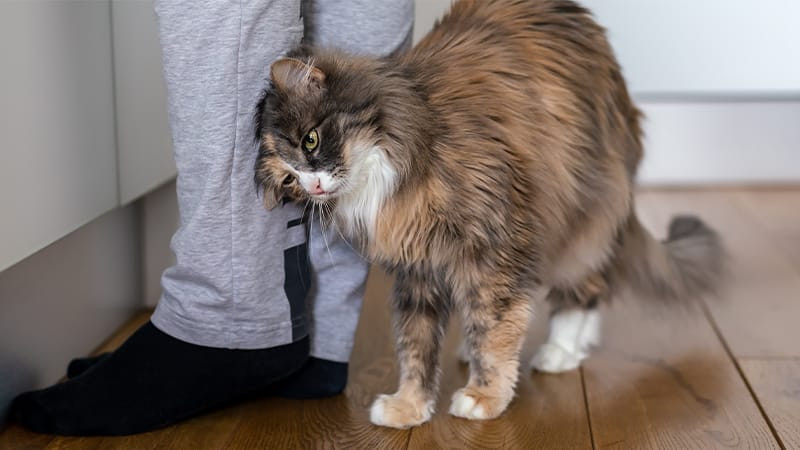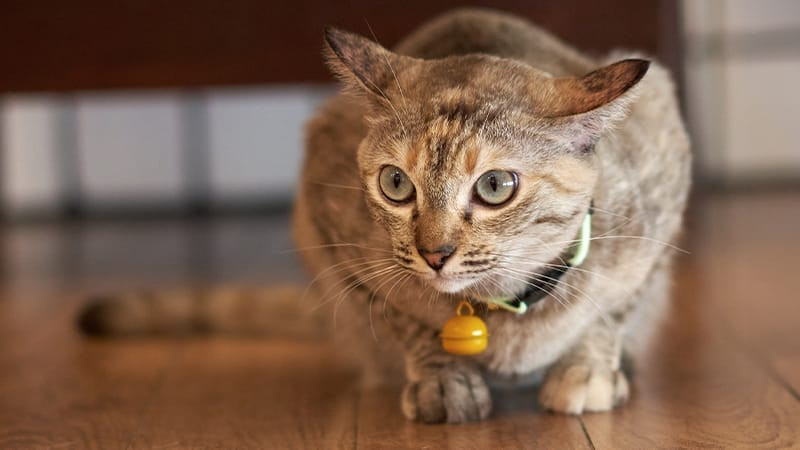Cats, with their enigmatic nature, exhibit a range of behaviors that can sometimes leave their human companions scratching their heads. However, by delving into the world of Cat Behavior, we can unlock a deeper understanding of these fascinating creatures, strengthen our bond with them, and ensure they receive the best possible care. If you’ve ever pondered the reasons behind your cat’s peculiar actions, this guide, drawing on insights from veterinary experts at MedVet, will illuminate the meaning behind common feline behaviors.
Understanding Physical Cat Behaviors
The Mystery of Cat Napping
Ever wondered why your cat seems to spend a significant portion of their day asleep? This behavior is deeply rooted in their evolutionary history. While domestic cats no longer rely on hunting for survival, their genetic programming still dictates periods of rest to conserve energy for bursts of activity. Cats possess a slightly higher basal body temperature than humans, making them instinctively seek out warm and cozy spots for their naps. You’ll often find them luxuriating in sunbeams, snuggled on warm appliances, or burrowed under blankets – all in pursuit of the perfect napping temperature.
Why Cats Eat Grass: A Green Snack or Something More?
Observing your cat munching on grass might seem odd, but this is a surprisingly common behavior with several explanations. For some cats, grass acts as a natural digestive aid. The indigestible fibers can function as a mild laxative, helping to clear their system and, importantly, assist in the expulsion of hairballs. For others, grass may simply be an appealing snack, satisfying a natural urge to chew and explore different textures. Furthermore, grass can provide essential nutrients, offering vitamins and minerals that may be lacking in their regular diet. However, it’s crucial to ensure any grass your cat has access to is free from pesticides and harmful chemicals, as these can be toxic to felines.
 Cat Eating Grass
Cat Eating Grass
A tabby cat outdoors, carefully chewing on a blade of green grass, illustrating the common cat behavior of grass consumption for digestion and nutritional benefits.
Decoding Aggression: Why Cats Attack
Aggression in cats, whether directed towards people or other pets, can be a complex issue with various underlying causes. Often, aggression stems from feelings of anxiety or fear, territorial instincts, or a perceived threat to their safety or resources. Creating a secure and stimulating environment for your cat is paramount in mitigating aggressive tendencies. This includes providing safe spaces, minimizing stressors, and utilizing positive reinforcement training techniques to encourage calm and confident behavior.
The Curious Case of Knocking Objects Over
That seemingly mischievous act of batting objects off shelves or tables is actually rooted in a cat’s natural curiosity and exploratory nature. Cats use their paws to investigate their surroundings, interacting with objects through touch. When a pushed object rolls or moves, it can trigger their predatory instincts, mimicking the movement of prey trying to escape. This playful behavior allows them to engage their hunting drives, providing both mental and physical enrichment.
Gifts from Your Cat: Understanding “Presents”
Finding a dead bird, rodent, or insect “gifted” to you by your cat might be unsettling, but it’s actually a sign of affection and their perception of you as part of their family group. Cats possess a strong hunting instinct, and in their eyes, they are contributing to the well-being of their “pack” by sharing their catch. This behavior may also be linked to their kittenhood experiences, where their mothers would bring them food and teach them hunting skills. Consider it a somewhat unconventional, but heartfelt, expression of care.
Inappropriate Urination: Beyond Litter Box Issues
Urinating outside the litter box, or on soft surfaces like beds, is a behavior that can be frustrating for cat owners. While it can sometimes be a sign of stress or dissatisfaction with their litter box setup (cleanliness, type of litter, location), it’s also crucial to consider potential medical reasons. Ensure your cat has access to clean litter boxes in quiet, accessible locations and experiment with different types of litter if needed.
Importantly, urinary issues can also be indicative of underlying health problems. Urethral obstruction, a serious and potentially life-threatening blockage of the urinary tract, is a common emergency in cats treated at MedVet. This condition can be caused by urinary crystals, stones, tumors, or urethral strictures. If you observe your cat vocalizing excessively, making frequent trips to the litter box, straining to urinate, or excessively licking their genital area, immediate veterinary consultation is essential to rule out any medical conditions.
The Scratching Post Dilemma: Satisfying a Natural Need
Scratching is an intrinsic cat behavior that serves multiple purposes. It’s essential for maintaining claw health, as scratching helps cats shed the outer layers of their claws, keeping them sharp and functional. Scratching also provides a full-body stretch, maintaining muscle tone and flexibility. Furthermore, it’s a vital form of territorial marking. Cats have scent glands in their paws, and scratching leaves both visual marks and scent cues, communicating their presence to other cats.
To protect your furniture, provide your cat with appropriate scratching outlets such as sturdy scratching posts or boards. These should be tall enough for a full stretch, stable, and covered in appealing materials like sisal rope or carpet. Placing scratching posts near furniture they are prone to scratch can help redirect their scratching behavior. Regular nail trimming is also a helpful management strategy to minimize potential damage.
The Zoomies Explained: Bursts of Feline Frenzy
Those sudden bursts of high-speed running, leaping, and general silliness known as the “zoomies” are a perfectly normal cat behavior. These energetic episodes are simply a way for cats to release pent-up energy. To channel these bursts constructively, engage your cat in interactive play sessions using toys that mimic prey, such as feather wands or laser pointers. Regular playtime can help expend energy, provide mental stimulation, and reduce the frequency and intensity of the zoomies.
Self-Care Cat Behaviors: Grooming and Hairballs
Grooming Rituals: Cleanliness and Bonding
Cats are meticulous groomers, dedicating a significant amount of time to keeping themselves clean. This self-grooming behavior minimizes the need for human intervention in bathing and grooming. Cats also lick humans as a sign of affection and social bonding. Normally, the hair ingested during grooming passes through their digestive system without issue. However, excessive grooming, often triggered by stress or underlying medical conditions, can lead to hairball formation. When a significant amount of hair accumulates in the stomach and mixes with digestive fluids, it can trigger regurgitation. The characteristic gagging, hacking, and retching sounds associated with hairballs are usually unmistakable. If these episodes become frequent, prolonged, or are accompanied by loss of appetite, lethargy, constipation, or diarrhea, it could indicate a hairball blockage requiring veterinary attention.
 Cat Grooming
Cat Grooming
A close-up image of a ginger cat diligently grooming its paw, highlighting the self-care behavior of grooming for cleanliness and coat maintenance.
Vocal Cat Behaviors: Purrs, Meows, and More
The Language of Cat Sounds: Purring, Meowing, Hissing, and Beyond
Cats are surprisingly vocal creatures, using a diverse range of sounds to communicate their needs, emotions, and intentions. From the familiar meow to hisses, growls, purrs, and chirps, each vocalization carries meaning. Meowing is often primarily directed towards humans, serving as a way to solicit attention or communicate needs. Hissing and growling are clear indicators of fear, defensiveness, or aggression. Purring is typically associated with contentment and pleasure, but it can also occur when a cat is in pain or stressed, acting as a self-soothing mechanism. Learning to recognize and interpret these vocal cues is key to understanding and responding appropriately to your cat’s communication.
Nighttime Squalling: Vocalizations in the Dark
Cats that squall or vocalize excessively at night can disrupt sleep for both themselves and their owners. One primary reason for nighttime squalling is related to mating instincts. Unspayed or unneutered cats, particularly females in heat (estrus), will vocalize loudly and persistently at night to attract potential mates.
However, even spayed or neutered cats may squall at night for attention-seeking purposes. They may learn that vocalization leads to interaction, food, or petting from their owners, reinforcing the behavior. To minimize nighttime squalling, ensure your cat is indoors at night to reduce exposure to mating triggers. Creating a calming bedroom environment with dim lighting or a nightlight and relaxing scents like lavender may also promote more restful sleep.
It’s also important to consider potential medical causes for nighttime vocalization, especially in older cats. Age-related sensory decline, such as decreased vision or hearing, can lead to anxiety and nighttime squalling as they seek reassurance. Furthermore, certain medical conditions, including hyperthyroidism, hypertension, hypokalemia, thiamine deficiency, and intracranial masses, can also manifest as nighttime vocalization. If you are concerned that your cat’s nighttime squalling may be due to a medical issue, consulting your veterinarian is essential for diagnosis and appropriate care.
Body Language Cat Behaviors: Silent Communication
Kneading Paws: Comfort and Contentment
The rhythmic pushing of paws against soft surfaces, known as kneading, is a common and endearing cat behavior. This action is deeply rooted in kittenhood, mimicking the nursing behavior used to stimulate milk flow from their mother. In adult cats, kneading is a sign of contentment, relaxation, and feelings of security. It can also be a way for cats to express affection and mark their territory through scent glands located in their paws.
Head Bunting and Rubbing: Scent Marking and Affection
When your cat gently rubs their head against you or objects in your home, it’s a multifaceted communication signal. Cats have scent glands on their heads, and head bunting and rubbing are ways of depositing their scent, effectively marking territory and claiming ownership. Simultaneously, it’s a clear display of affection and social bonding. They are essentially saying “you belong to my group.”
 Cat Head Rubbing
Cat Head Rubbing
A tortoiseshell cat gently rubbing its head against a human hand, demonstrating the affectionate behavior of head bunting for scent marking and bonding.
Ear and Tail Talk: Decoding Feline Signals
A cat’s ears and tail are highly expressive and provide valuable insights into their mood and intentions. Forward-pointing ears typically indicate attentiveness, curiosity, and focus. They may be intently observing something in their environment or preparing to pounce. Conversely, flattened or backward ears often signal fear, aggression, anxiety, or discomfort.
The tail is another crucial communication tool, conveying a wide spectrum of emotions. A relaxed, gently swaying tail suggests contentment and calmness. An upright, puffed-up tail is a clear sign of aggression, fear, or defensiveness. A flicking or twitching tail can indicate excitement, anticipation, or agitation, depending on the context and other body language cues.
 Cat Ear Movement
Cat Ear Movement
A close-up shot of a cat’s head, focusing on its ears pointed forward in an alert and attentive posture, illustrating ear movement as a form of cat communication.
Recognizing Pain: Subtle Signs to Watch For
Cats are masters at concealing pain, making it challenging to recognize when they are suffering. Subtle changes in cat behavior are often the most reliable indicators of pain. If your cat exhibits any unusual or uncharacteristic behaviors, such as inappropriate elimination (urinating or defecating outside the litter box), increased aggression, self-mutilation (excessive grooming to the point of injury), or changes in their usual routines, pain should be considered as a potential underlying cause. If you suspect your cat is in pain, prompt veterinary consultation is crucial for diagnosis and pain management.
Understanding your cat’s diverse range of behaviors is fundamental to fostering a strong and harmonious relationship. By learning to decode their actions, vocalizations, and body language, you can better understand their needs, provide appropriate care, and create a nurturing and enriching environment for your feline companion. Remember that every cat is an individual, and their behaviors can vary. Observing their unique cues and paying attention to their overall demeanor will deepen your connection and enhance your shared life. Embrace the journey of understanding and connecting with your fascinating feline friend!
For exceptional emergency and specialty veterinary care, find a MedVet near you.

